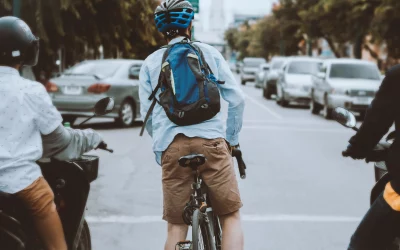Top Rated Bicycle Accident Lawyers in Colorado Springs
Bicycle accident claim compensation will be at the top of your mind at a bicycle crash in Denver. Approximately 45,000 bicycles are wounded or killed each year as a result of accidents with automobiles.
Injury to a cyclist due to a collision with a car, truck, or other traffic danger may be life- threatening. Your bike is wrecked, and you might be out of commission for weeks or even months. What are your options?
You want to ride your bike safely and avoid any potential risks at all times. However, suppose you have been wounded in a bicycle accident that was the fault of another. In that case, you are entitled to compensation for your property damage, personal injuries, as well as your agony and suffering.
Following these procedures will assist you in putting together a compelling bike accident claim with the insurance company of the at-fault motorist.
THE FIRST STEP IS TO GATHER EVIDENCE AT THE SCENE
Always dial 911 if you are involved in a motor car accident. Inform the dispatcher that you were riding a bike when you were struck by an car if you were hurt, where the accident occurred, and whether the car driver that hit you left the scene.
Find Out Who Is At Blame
- Information for the driver
- If you are able, get the following information from the at-fault driver:
- Full name and contact details (including email address).
- The name and policy number of your auto insurance company
- Your driver’s license or permit
- You’ll also need the following information about your car:
- Make, model, and year of manufacture
- Car Identification Number (VIN)
- License Plate Number (if applicable)
Keep An Eye On What You Say
Don’t let the apologies of the at-fault motorist detract from your focus. Your first instinct to a driver who has struck you could be to forgive them, mainly if the apology seems natural to you. Or, even
worse, you could remark something along the lines of “I should have been more cautious.” Please don’t do that.
Comments such as “I’m OK” or “I’m fine” are what attorneys and insurance companies refer to as “admissions against interest,” and they are illegal. The insurance company representing the at-fault driver will use your comments against you to reject or restrict your claim.
Everything you say may be used against you throughout the settlement bargaining process. Except obtaining the driver’s contact and insurance information, you should save your remarks for the police officers who have been summoned to the site. They will compile a police report, which you may use as evidence in court later on.
Here’s how to determine who was at fault in a bicycle-car collision.
Make A List Of Everything
When you are struck by a car, pay careful attention to any confessions of fault by the motorist who hit you.
Make thorough notes for yourself as soon as possible after the accident, while the details are still fresh in your memory. Include anything that the other driver or passengers have mentioned in your report. The driver’s admissions may be used to determine who was to blame for the collision.
Nothing should be left out. It is always preferable to have too much knowledge than to have too little information. It’s normal for people to forget important information after just a few days, and bicycle accident claims may take months, if not years, to be resolved in court.
Look For Potential Witnesses
Please make a note of any witnesses to the bicycle-car collision and provide them to the police. Unless you tell the officers who they are and what they look like, you may miss out on the chance to have their remarks included in the official police report.
After notifying the authorities of any potential witnesses, please make an effort to get their contact information. See if they are willing to submit a short statement describing what they saw while on the scene. Insist on their signing and dating each page.
If your injuries make it impossible for you to communicate with witnesses, ask a kind stranger to assist you.
Keep An Eye Out For Potentially Hazardous Road Conditions
You should take note of the precise location where you were wounded if you crashed your bike due to barriers or damage to the roads, such as broken pavement or potholes, after the accident. Mile markers, street signs, and other landmarks should be sought.
Use your camera or mobile phone to picture the area, making sure to capture important landmarks such as businesses, cross-street signs, and other identifiers.
Having the location information can assist you in determining whether the state or your local municipality was responsible for the upkeep of the roads.
Following the determination of the appropriate highway jurisdiction, you may file a personal injury
claim with the proper government division. Make a hasty decision. Some state and local governments require injury claims to be submitted as soon as possible after the event, sometimes as soon as 30 days.
Photographs Should Be Taken
Take as many images and videos of the accident site as you can using a camera or your mobile phone, if at all feasible.
Include any damaged components from your car as well as your bicycle in your list. Take photographs of any skid marks, street signs, guardrails, or other things that have been damaged as a result of the accident. Take pictures of your injuries, as well as any injuries or bleeding clothes you may be wearing.
Don’t make your injuries worse by attempting to gather proof after the accident has occurred. Increasing the severity of your injuries is not beneficial for you and might hurt your claim. If you’ve been seriously injured, you should ask someone else to photograph the situation.
SEEK MEDICAL ATTENTION AND DOCUMENT YOUR INJURIES.
The majority of personal injury settlement offers are based on the number of medical costs incurred by the claimant. Getting medical attention and documenting your injuries is critical in making a successful claim if you are involved in a bike accident.
Never decline medical treatment when it is offered at the spot. Your heart will be racing, and your blood will be pounding immediately after a collision. Adrenaline is a powerful painkiller that may even conceal significant injuries.
This is not the time to maintain a stern demeanor. Inform the paramedics of any symptoms, no matter how little. Don’t try to make excuses for your symptoms by blaming them on your age or upbringing. If the paramedics tell you that you need to be sent to the hospital, follow their instructions.
If you didn’t go to the hospital right away after the accident, make an appointment with your primary care physician as soon as possible, ideally the same day.
You should go to the hospital emergency department or an urgent care facility if your physician isn’t accessible at the time. Follow-up with medical therapy as directed by the emergency department physician is required.
It is very detrimental to your claim if you refuse or postpone medical care following an accident. Because your injuries are not connected to the accident, insurance companies will leap at the opportunity to reject your claim. This is true even if you wind up flat on your back later on.
Throughout your rehabilitation, take photographs of your injuries to document your progress. Bruises and swelling are common and might develop over many days. Rashes on the road scab and weep.
You should ask someone to snap a photo of you on your hospital bed if you’re admitted to the hospital. If your case goes to trial, injury photographs may assist you in persuading a jury of the extent of your pain and suffering.
ENSURE THAT THE VALUE OF YOUR CLAIM IS PROTECTED.
A bicycle collision should be treated with the same seriousness as a car accident. Too many motorists assume that colliding with a bicycle does not constitute a severe accident. The car may either slow down to observe what occurred or speed away, blaming the cyclist for being on the
road in the first place.
When a car fails to stop after hurting a bicycle, they are guilty of felony hit-and-run. If this occurs, contact the authorities immediately.
In nine out of 10 bike accident cases, the motorist will not be required to compensate the wounded rider out of their own money. Personal injury compensation is paid by the insurance company of the at-fault motorist, not by the driver’s assets or assets.
Having Well-Organized Paperwork Can Aid You In Your Claim.
Inquire the responding officer for the reference number for the police report. For a small cost, the information should be accessible within a few days of the accident.
You’ll need copies of your medical bills and documents, as well as receipts for any out-of-pocket costs, such as crutches, prescriptions, and bandages, to file a personal injury claim. Keep track of your mileage as you travel to and from treatment or therapy sessions since you will be required to provide those data as well.
The value of your claim will be increased if you have well-organized supporting evidence of your injury expenditures.
Taking Care Of Business With The Insurance Company
Even if you can walk away from a car accident while riding your bike, being struck by a car while riding your motorcycle. You will likely be able to settle your claim for a reasonable amount of money without the assistance of an attorney if your losses are restricted to soft-tissue injuries such as scrapes, bruises, sprains, or minor cuts.
Claims for soft-tissue injuries are often uncomplicated. They agree to compensate you for the whole amount of your medical and treatment costs, out-of-pocket expenditures, missed income, and a restricted amount for pain and suffering if you are injured.
Hard injury claims, on the other hand, are a different situation. Bike riders often suffer severe injuries in car accidents, including head trauma, spinal cord injuries, permanent scarring, bone fractures, and internal injuries.
Head trauma, spinal cord injuries, permanent scarring, bone fractures, and internal injuries are standard. Complex injury claims are time-consuming and costly to pursue.
Don’t believe the insurance adjuster who tells you that you won’t need an attorney for your hard injury claim or that you won’t be able to get compensation since you weren’t wearing a bike helmet during the accident. The adjuster’s primary concern is the company’s profit margin, not what is fair for you and your family.
The reality is that insurance adjusters are well-known for offering lower settlement offers to wounded claimants who do not represent themselves in court. The reason is that after they’ve presented you with their “last offer,” you won’t have the energy or legal know-how to oppose them.
When you’re dealing with catastrophic injuries, there’s too much at stake to attempt to manage the insurance company on your own. Get the monetary compensation you are entitled to. Obtain legal advice from a personal injury attorney to determine the actual value of your claim.
Warrior Car Accident Lawyers
1902 W. Colorado Ave., Suite 100
Colorado Springs, CO 80904







